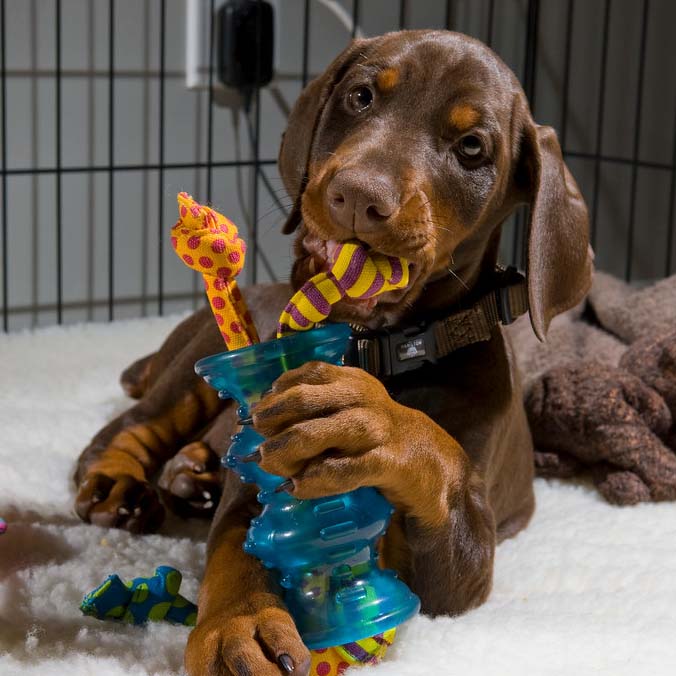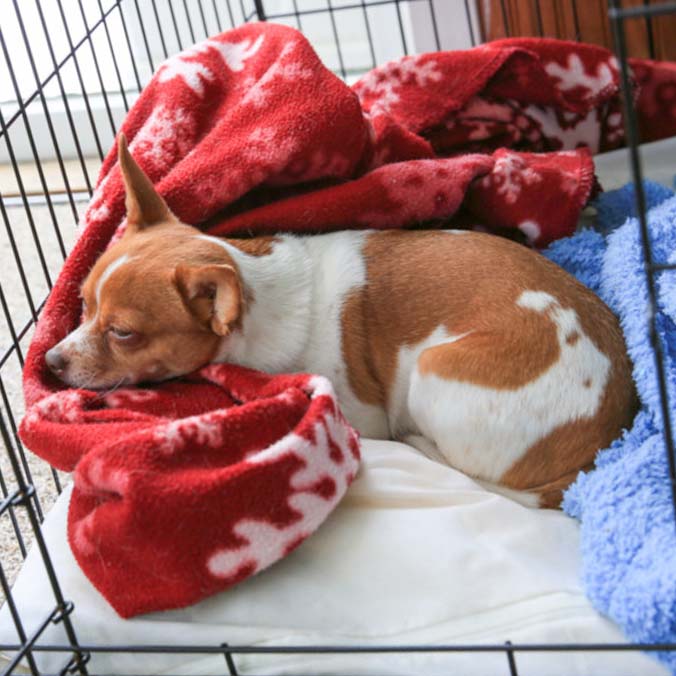We first published a version of this blog post almost a decade ago when our founder returned from a visit to Cesar Millan’s workshop. Every trainer at the workshop agreed: the crate was, without question, the most underutilized tool by pet parents.
The same holds true today. For that reason, we’re publishing our second crate training post this year. This time, we’re focusing on adult dogs.
Image credit: Kingsport Humor
Adult dog crate training works. Yes, you can teach an old dog new tricks.
Image credit: RSPCA
Avoid using the crate as punishment. Positive association is the key to success.
Benefits of Adult Dog Crate Training
Crate training is not just for puppies. It has positive applications for dogs throughout their entire lifetime. Kenneling an adult dog can help with: travel, boarding, vet trips, entering new environments, meeting new kids and adults, protection from destructive behavior and (when done right) relaxing in high-stress situations.
Although many owners use a crate when their dog is a puppy, they want to phase it out after the puppy is housebroken or potty-trained. This idea stems from myth and dog owner guilt. We strongly recommend keeping your dog comfortable being in a crate throughout their lifetime.
Dogs are den dwelling animals and when crate training is done properly, they will have a positive association. If you only remember one phrase after reading this, remember positive association. When crate-trained correctly, your dog will view the crate as their den and safe space. Once this is established, the last thing we want to do is take that away from them.
Rethink the Purpose of the Crate
The crate is not a tool for punishment. Sometimes people get caught up in the idea that by putting your dog in a crate, you are restricting freedom or giving them a “time out.” We want the crate to be a positive place and a safe place for your dog to relax.
When dogs are alone in the house they can’t turn on the tv or read a book, so crate training them is a fantastic way to keep them from “getting into trouble” while you are out. This includes everything from chewing on a shoe to ingesting dangerous items.
Although some dogs are true couch potatoes, most are not. Think about your dog’s temperament here. If you have a higher energy dog, they are more likely to get bored and look for something to do.
If you were to set up a camera and leave your dog loose while you are away, you might be surprised to see your dog pacing, barking out the window, or chewing destructively. These behaviors are common for many dogs and can make separation and isolation anxiety worse.
When your dog is comfortable being in their crate while you are away, they might chew on a bone for a moment and then take a nap. This keeps them calm and relaxed. Calm and relaxed is always a healthier choice than a frenzied state.
Utilizing the Crate in Various Scenarios
Even if you have a dog that sleeps on the couch while you are away it is good to keep crate training part of their life for several reasons:
Travel by Car or Plane
Anyone who has ever been on a long road trip with a dog, knows travel can be stressful for them. Do your dog and yourself a favor by bringing the crate. They will bounce around less in the car, which is safer for both the driver and dog. The crate can even help with car sickness! Overall the trip will be more enjoyable for everyone involved.
Boarding, Grooming and Vet Appointments
If your dog goes to daycare, overnight boarding, gets groomed regularly or needs to stay at the vet for longer than a check-up, they’re going to be staying in a crate. The experience will be far less traumatizing for your dog if they already view the crate as a safe and relaxing place.
Introducing a New Dog to Your Home
An environmental change is a big deal to a dog! Adult dog crate training can help to ease the transition. Recently we discussed introducing a new baby to your dogs. The concept is largely the same. If you’d like a detailed explanation and some tips for a successful integration, check out this full post by CPM trainer and new mom, Frida Covarrubias.
When You Have Guests or Workers In Your Home
Believe it or not, some people are afraid of dogs. Entering a home with a loose dog can be especially unnerving for workers who are coming in and out for home renovation or repair. When you have people visiting who do not want to interact with your dog, use the crate. Your guest will be more relaxed and your dog will be less stressed out not being exposed to their nervous energy.
We also recommend using the crate when guests who aren’t afraid of dogs arrive. This way, you control the pace of the introduction and can slowly integrate them into the social situation after the commotion of their arrival calms down. This also teaches your dog that if they are unexpectedly loose when someone surprise visits (or a delivery), they will learn that not every person “loves dogs.”
Potty Training an Adult Dog
Can’t teach an old dog new tricks? Not true. That myth stems from dog owner failure. When adult dog crate training is performed properly, it works great for potty training adult dogs. You want to take the same approach you would with a puppy.
Unwanted Behavior
We often have owners who describe a “witching hour,” when their dog seems to misbehave more (mouthiness, barking for attention, etc). Whether the dog is overtired or looking for something to do, the crate can be utilized (assuming we have already met their mental and physical needs for the day). The crate is a simple, effective, and positive change of energy for the dog. We don’t want our dog to mistake the crate for a negative, so never put them in to stop behavior. Always address the behavior you want to stop and redirect your dog, then, you can calmly have them go to their crate. If your dog associates the crate with rest and relaxation, we are teaching them to go into that mode instead of the other. This is also a very subtle training technique for impulse control.
Adult Dog Crating Tips
Whether you’re attempting to crate train your dog for the first time or reintroducing the crate after a break, following these tips will improve your chances of success:
Choosing a Crate
First make sure you get the proper size. Your dog should be able to stand and turn around comfortably. Many people buy crates that are too large and can have difficulty with potty training because of that. If you have a puppy, always use the divider or you can get a cheap used crate off resale sites or garage sales. Some dogs are more comfortable in a plastic crate because it is darker and feels more like a den. Other dogs prefer a wire crate where they can see what is going on around them. If you are purchasing a crate for travel, always get a plastic or reinforced crate.
Starting Out
In the beginning, always exercise your dog before crating. This is to get them tired and can be either mental or physical work. It teaches them that the crate is a restful place. It also helps to cut down on whining when they are in the crate. If using a wire crate, having a crate cover (or an old blanket) to block the light can help simulate night time.
Treats and Feeding in the Crate
Take the door off the crate or bungee it open and throw some high value treats or their favorite toy in the crate when your dog is not looking. Let your dog discover what’s in there, and enter the crate on his own without praise or coaxing. Start feeding them next to the opening and over the course of a few days, move the bowl further into the crate. Your goal is for them to eventually go in first and then you can put the bowl into the crate and close the door while they eat. We recommend this to all clients, but especially multi-dog homes.
Crate While You Are Home (and Away)
If you only crate your pup when you leave the home, they will associate the crate with being left. Remember to crate him or her during the day, when you are home at different times and for varied lengths of time. This is especially important when you have time off from the office or you work from home.
Avoid Using the Crate for Punishment
If you’ve made it this far, you might notice that we are repeating this tip. That’s because it cannot be overstated. Positive association leads to less stress and a healthier dog.
Key Takeaways
You might not remember all of the information we posted here but if you remember the following key takeaways, you’re in good shape!
- Crate training is beneficial for dogs of all ages.
- Adult dog crate training works. Yes, you can teach an old dog new tricks.
- Think of your dog’s crate as his or her den.
- Avoid using the crate as punishment. Positive association is the key to success.
- Stop feeling guilty!
If you’ve slacked a bit on your dog’s training, give crating a try. If you are a Canine Peace of Mind graduate, your dog has already experienced a positive association with the crate.
*If you think you need some help from the pros, feel free to contact us via the website or on social media. The team will get you pointed in the right direction.
*This post was updated in December of 2022









